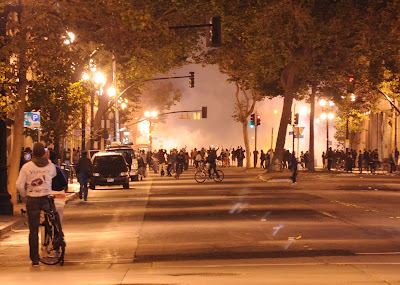 |
Student group - Fara Enclave (photo by César Alvarez)
|
In 2008 I was asked to teach a single course in the Music Tech division of the Creative Arts and Technology Department at Bloomfield College called "Digital Audio Engineering 1." I approached the class as a composer, producer and sound artist assuming that most of my students would be primarily interested in figuring out the studio tricks to make their tracks sound radio loud, compressed and commercial. I was right to a certain degree but what I did not expect is that they were hungry for a set of fundamentals around which to build a mature and unorthodox artistic practice. What sets the students in this program apart is that most have not been through traditional high school music programs but arrive at the practice of music making through their home computers. They are an entire crop of computer musicians that are from diverse backgrounds and musical tastes, and have little in common musically with the experimental electronic musicians that for decades have owned the title "computer musician." Home computers are enabling a whole generation of young people to make music without access to traditional musical instruments (much as the turntable did in the 1980s). Now a lot of these musicians are looking for a way to pursue that interest as part of their higher education. These musicians are the future of the music industry.
After seven semesters and 100s of classroom hours at Bloomfield I've started to identify an emergent framework for undergraduate study of "studio" music as a combination of creative and technical practice with historical and cultural study. The music industry is undergoing a cataclysmic transformation right now. and from what I can tell (looking at job postings and course offerings) many music departments at colleges and conservatories are stubbornly resisting the uncomfortable questions that this transformation raises for their curricula and pedagogy. I believe that creative and cultural workers will be highly sought after in the 21st century economy yet many of our music majors are being given a seriously dated education that ill-prepares them for this exciting yet dangerously uncertain field. Furthermore, many musicians are being excluded wholesale from the serious study of music because they lack the traditional pre-requisites (instrumental training, knowledge of jazz or classical music, ability to read music, etc) or because they are interested in popular music. My students have many careers open to them and most will wear several hats in order to collage together a respectable living as an artist. They will be performers, composers, recording artists, engineers (recording, mixing, mastering), sound designers, producers, bloggers, DJs, venue owners, bookers, teachers and live sound engineers. They will work at record labels, game design firms, post-production houses, event companies, marketing firms, radio stations, studios, internet start-ups, and even for sports teams. And their musical training will serve them in all of these roles.
After seven semesters and 100s of classroom hours at Bloomfield I've started to identify an emergent framework for undergraduate study of "studio" music as a combination of creative and technical practice with historical and cultural study. The music industry is undergoing a cataclysmic transformation right now. and from what I can tell (looking at job postings and course offerings) many music departments at colleges and conservatories are stubbornly resisting the uncomfortable questions that this transformation raises for their curricula and pedagogy. I believe that creative and cultural workers will be highly sought after in the 21st century economy yet many of our music majors are being given a seriously dated education that ill-prepares them for this exciting yet dangerously uncertain field. Furthermore, many musicians are being excluded wholesale from the serious study of music because they lack the traditional pre-requisites (instrumental training, knowledge of jazz or classical music, ability to read music, etc) or because they are interested in popular music. My students have many careers open to them and most will wear several hats in order to collage together a respectable living as an artist. They will be performers, composers, recording artists, engineers (recording, mixing, mastering), sound designers, producers, bloggers, DJs, venue owners, bookers, teachers and live sound engineers. They will work at record labels, game design firms, post-production houses, event companies, marketing firms, radio stations, studios, internet start-ups, and even for sports teams. And their musical training will serve them in all of these roles.
Below I've begun to document some of my observations and classroom experiments in order to start a dialogue about non-conservatory non-traditional undergraduate music education, both to document them for myself and hopefully to initiate a dialogue about the future of the music industry through the lens of some its youngest participants. I've also included a resource list at the bottom of the post.
Here are some of the basic concepts and distinctions that I employ in my classes along with brief explanations:




